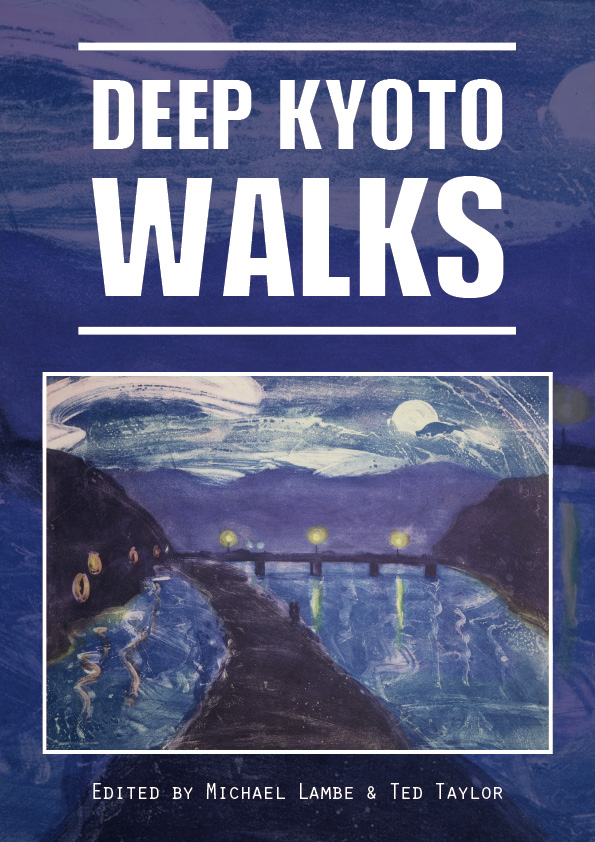
A new e-book, available on all Kindle devices or through the Kindle app, featuring 16 authors as well as the co-editors
Kyoto is known as a city of Buddhism. Most of the head temples of the major sects are based here, and the most important events in Japanese Buddhist history took place here. Indeed, Mt Hiei is known as ‘the mother of Japanese Buddhism’.
However, it’s also a city of shrines (500 or more), some well-known but many, many more of minor importance yet bearing long and fascinating histories. This is, of course, because the city was long home to the imperial family, whose ancestors were regarded as kami. Shrines dedicated to them, or to those who served them, can be found dotted all around, many dating back a millennium or more.
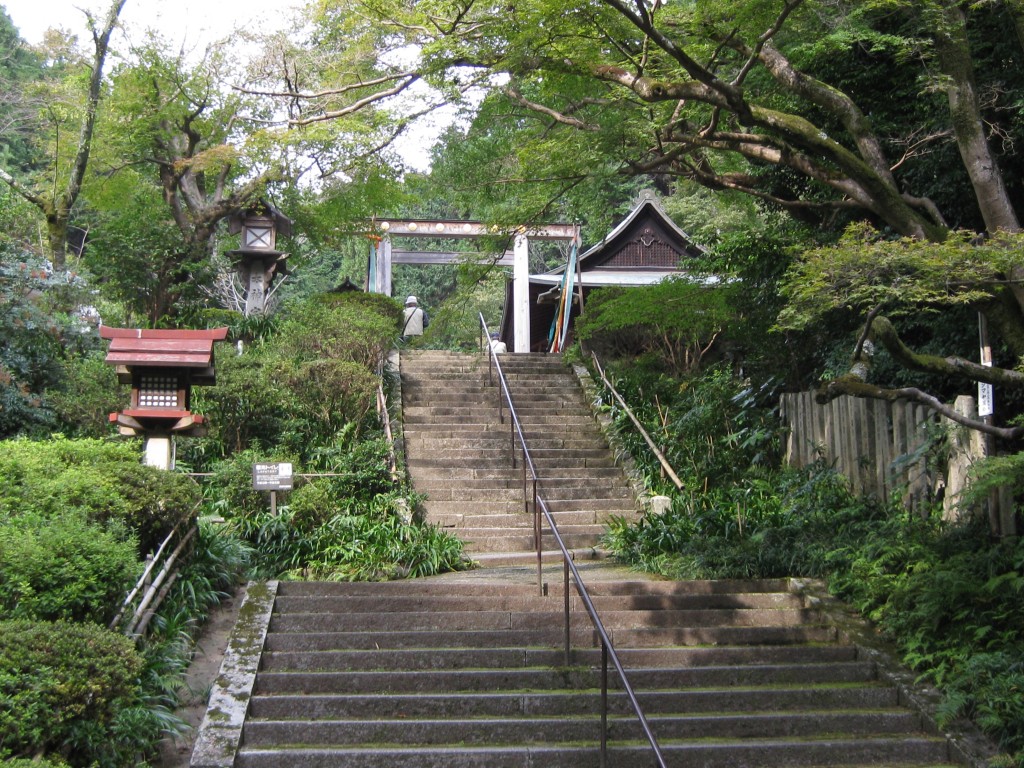
The alluring entrance of Himukai Daijingu, once a bustling shrine of walkers from the nearby Tokaido pathway to Edo
Some of Kyoto’s wealth of shrines are covered in an exciting new e-book containing personal rambles through the city by 18 different authors. There’s a piece about walking the Kyoto Trail around the city. There’s also an account by myself of walking along the Kamo River, which features Shimogamo Jinja and former priest Kamo no Chomei, author of the wonderful Ten-Foot Square Hut (1212).
Editor Michael Lambe includes Himukai Daijingu on his walk, one of several shrines with competing claims to be the city’s oldest (along with Shimogamo, Kamigamo and Matsuo). Such is the antiquity of the shrines, dating back long before Kyoto was founded in 794, that no one knows for sure which was first.
In Edo times travellers on the Tokaido route stopped off at Himukai, which would have made it a bustling shrine for the route to the shogunate capital was one of the busiest thoroughfares in the world. Those leaving Kyoto would pray for a safe journey, and those arriving would say a prayer of thanks.
Michael takes in the Heian Jingu too, awed by the vastness of the grounds, and it prompts memories of his sister and of how he longed to be in Kyoto because of ‘a kind of peace in the air and a mysterious sense of promise’. He reveals too the unlikely fact that the thickly wooded Yoshida Hill, where the Yoshida Shrine stands, was covered in tea bushes some 100 years ago.
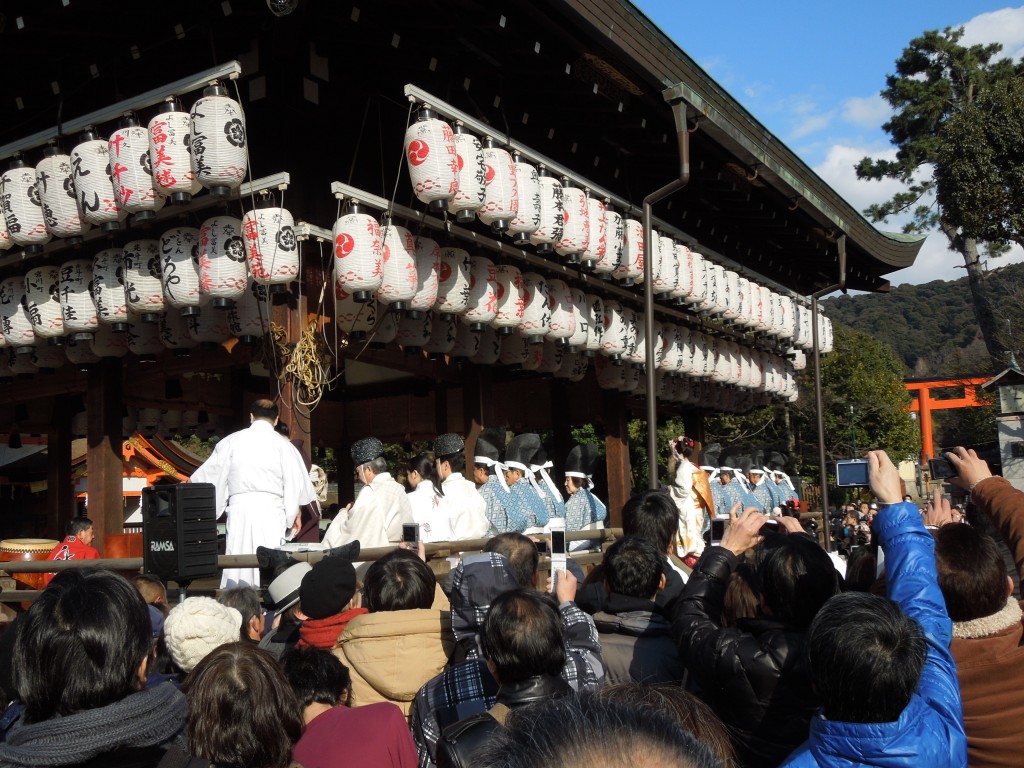
Yasaka Shrine in Gion, like a giant ship with lanterns
Bridget Scott takes in the Sagi no Mori Shrine, where she shelters from the rain on a wooden stage and overhears a priest chanting a dedication to a young couple. Here she feels that ‘the soul of ancient Japan whispers to me’.
In an account of how he first came to Kyoto, Pico Iyer imagines Yasaka Jinja as a giant ship with lanterns, noting that you can see women from the ‘water world’ at prayer and that at New Year mothers carry auspicious flames back to their homes. He comments too on the typical Kyoto juxtaposition of sacredness and peace beside noisy junction and busy shopping street.
The front of Toyokuni Shrine, along which runs a stone wall of giant rocks, impresses Jennifer Louise Teeter with its size and neat arrangement. She notes that the shrine’s ema (votive plaques) are shaped like gourds and that one bears a wish to be ‘as handsome as the characters in my favorite video game.’ But why gourd-shaped ema? It seems that Toyotomi Hideyoshi, to whom the shrine is dedicated, was known as Lord of the Gourds, and samurai under his command used them as emblems on the battle-field. In the shrine’s treasury, along with elaborate golden screens, are other items emblazoned with the gourd motif, and the shrine’s office even sells a gourd-shaped mobile strap.
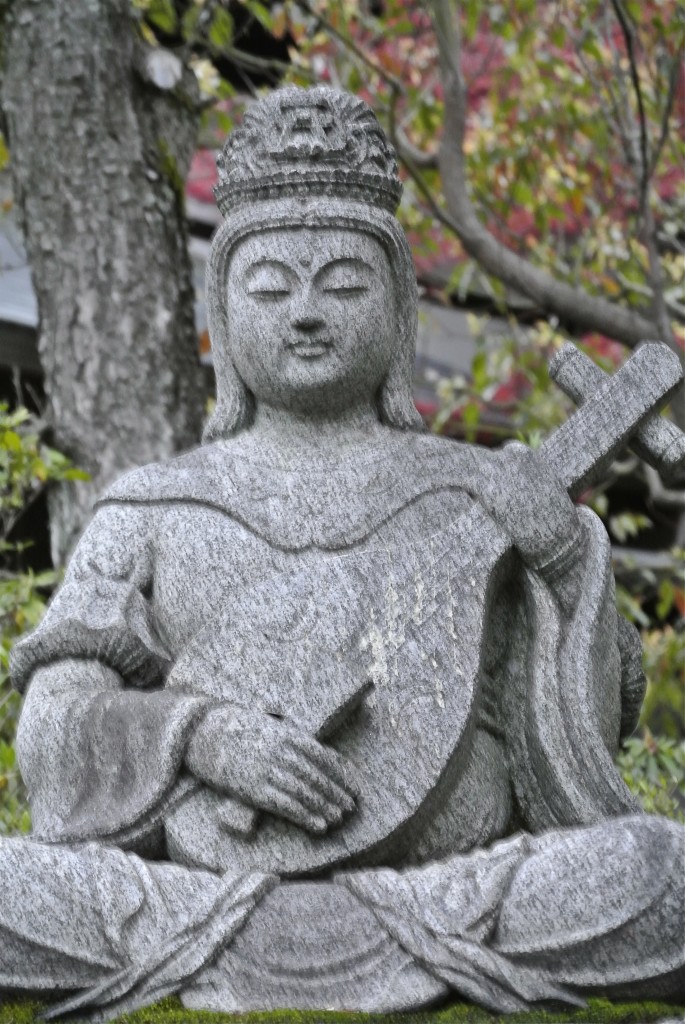
Benzaiten, muse for artists, also has a commercial interest
John Ashburne heads for the Nishiki Tenmangu, suitably enough for the shrine stands at the end of the food market and John specialises in writing about food. On the way he drops in to offer a prayer at Kandajin Shrine, built in 845, a quiet local shrine boasting ‘exquisite statues’ and ‘gorgeous shimenawa rope’. There’s also a municipally recognized Gingko Bilboa tree, the ancestors of which date back 270 million years. Being of culinary mind, he praises the nut for its essential role in the chawanmushi savoury custard. He informs us too that remarkably the tree type was one of the few living things to survive Hiroshima.
The small Hanjo Jinja, he notes, ‘like many of Kyoto’s sacred sites has a colourful history’. It was once syncretic and Buddhist, it honours Benzaiten, and it may have been originally built on a site known as ‘The Hill of Assembled Women.’
Benzaiten is usually associated with the arts but looks after commercial enterprises too, so John buys an ofuda with the shrine’s name in handwritten kanji for his wife’s café. At his end-goal of Nishiki Tenmangu, he also buys a fortune slip which tells him not to get lost in wild fancies. Food for thought, one might say…
Sanborn Brown gives a detailed account of the pilgrimage up Mt Atago on July 31, part of the annual Sennichi Tsuyasai festival when thousands climb the steep mountain at nighttime. He arrives back down from the top at 3.45 am to find that others are just about to set off. (The 8km round trip takes about four hours.) Distances up the mountain are measured by Jizo statues in red bibs and by forty placards set up by the fire department. Atago is Kyoto’s highest mountain, slightly taller than Mt Hiei at 924 meters.
At the top there used to be a Buddhist-Shinto complex, but after the separation of Buddhism from Shinto following 1868 the temple was converted to create Atago Shrine (the head of 1500 shrines nationwide). It is dedicated to Izanami and her child Kagutsuchi, god of fire (whose birth caused the death of Izanami). The shrine’s festival, created in the 1860s, therefore centres around protection from fire – a vital matter for a city of wooden houses.
Shrines are but one small part of Kyoto’s attraction, but as the Deep Kyoto Walks anthology shows there are few walks in the city that are not enriched by the presence of a small shrine, whether guarding the spirit of place, keeping a sense of history, or providing a focus for communal identity. Invariably they are surrounded by a patch of nature, or host to a sacred tree, protecting the rus in urbe that makes living here so pleasant. Together with the festivals they put on, shrines are a vital element in the lush brocade of Japanese culture. Truly, they are guardians of the national soul.
******************************************************
Deep Kyoto Walks contains a variety of walks in and around (literally all around) the city. Some delve into the past, some are concerned with the present, and some are highly personal. It is available on amazon at the following link… http://www.amazon.com/dp/B00KFM2J0C#sthash.1rnDlgoq.dpuf
Free Kindle apps for any kind of computer and i-pads etc can be downloaded to read the book here.
In a series of rambles that express each writer’s intimate relationship with the city, the authors take readers to more than just the famous shrines and temples, but to the backstreets of memory where personal history and that of the city intersect. Join Pico Iyer, Judith Clancy, Chris Rowthorn, John Dougill, Robert Yellin, John Ashburne and others as they explore markets and mountains, bars and gardens, palaces and pagodas and see Kyoto afresh through the eyes of those who call it “home”.
Included are:
· 17 illustrations
· A specially commissioned woodblock print by Richard Steiner
· 12 detailed maps
· Links to all locations on Google Maps
· Cover Art by internationally acclaimed artist Sarah Brayer
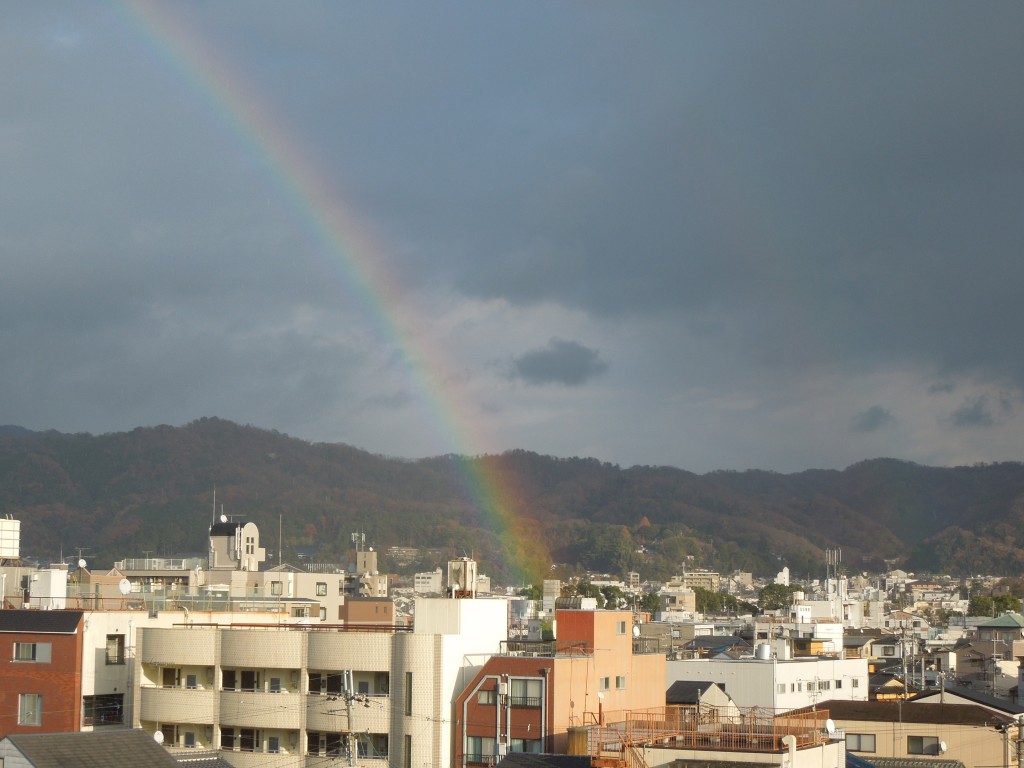
Walks through a magical city, touched by the gods. In shamanic cultures rainbows were seen as a bridge to heaven.
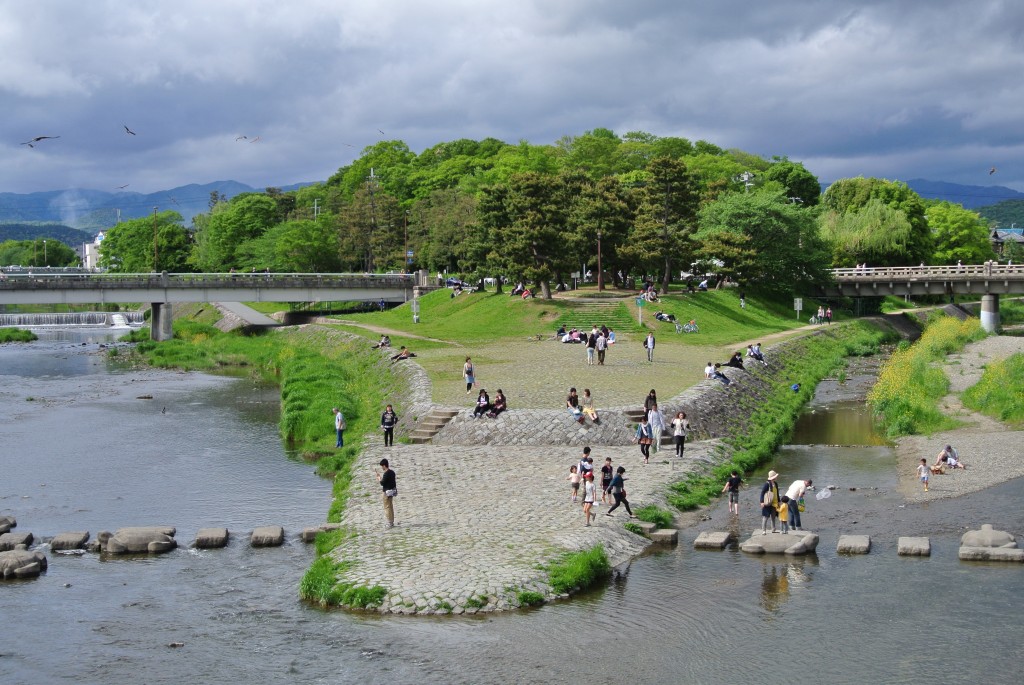
In 'Kamogamo Musing' John Dougill contemplates the ancient history of the river, including its 'power spot' of Shimogamo Shrine nestled in the junction between two rivers which flow down from the northern hills on their inexorable way to the Pacific Sea.

Interesting read, got myself a copy and enjoying the walks!
Thanks, Hugo. You have some great ‘secret places’ too on the Kyotodreamtrips blog…
Hey, I finally found your blog! Happy day!
I’m halfway through the book now and am thoroughly enjoying it. Lots of excellent anecdotes and memories litter the pages. It’s so much more than a guidebook!